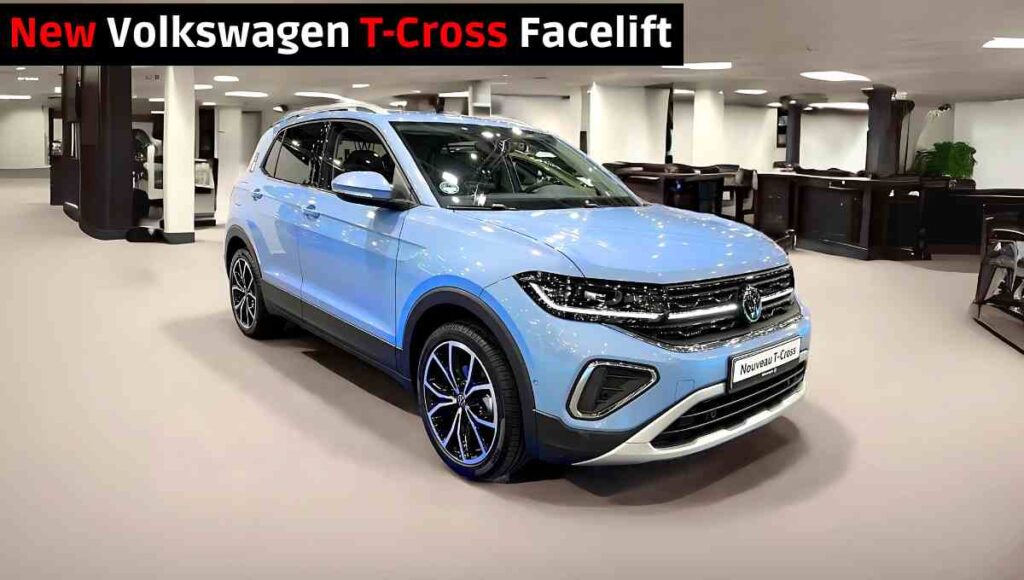The 2024 Volkswagen T-Cross Style facelift has hit the market, continuing its legacy as a popular compact crossover.
While its sales have been strong globally, the T-Cross had begun showing signs of age. With its latest updates, Volkswagen aims to rejuvenate the T-Cross and continue its success story. But is the facelift enough to keep this car competitive in an increasingly crowded market?
In this review, we take an in-depth look at the changes made to the T-Cross, including its engine options, design updates, and performance to assess if it’s worth the investment in a competitive segment that includes rivals like the Ford Puma, Toyota Yaris Cross, and Hyundai Bayon.
Table of Contents
VW T-Cross facelift Design Changes
The facelifted T-Cross might not look drastically different at first glance, but Volkswagen has made some key changes.
The front end gets updated aprons and a reworked grille, offering a more modern look. The fog lights now sport a more angular design, while the rear features new taillight graphics and additional reflectors in the rear bumper, making the car stand out a bit more. The silver underbody insert and the addition of new rim designs also give the T-Cross a more refreshed look.
The facelift has also lengthened the vehicle by 20 millimeters, improving its stance. The new colors, including the eye-catching Grape Yellow, are sure to attract attention.
Overall, the changes are not groundbreaking but do help bring the T-Cross up to date, making it a more attractive option in the crowded compact crossover category.
Interior
Volkswagen has clearly focused on improving the interior quality in the T-Cross facelift. The dashboard now features softer materials, and the door panels have been upgraded to reflect the brand’s commitment to higher-quality finishes.
The infotainment system, available in either 8.0 or 10.25 inches, feels modern and responsive. The larger screen comes standard in the R-Line variant and supports quick, logical interactions.
A major update to the controls includes the shift from traditional buttons to touch sliders for the climate control. While this change might not be to everyone’s liking, it represents a bold step toward making the interior feel more premium.
Thankfully, the steering wheel retains physical buttons, which many users will appreciate for their tactile feedback.
The seating comfort in the T-Cross is commendable. The car’s wheelbase is the same as the Polo, yet there is still ample room for passengers.
For those looking for cargo space, the T-Cross offers a trunk capacity ranging from 455 to 1,281 liters, which is quite competitive in the segment.
| Dimensions | Volkswagen T-Cross 1.5 TSI (2024) |
| Length x Width x Height | 4,127 mm x 1,784 mm x 1,573 mm |
| Wheelbase | 2,551 mm |
| Trunk Volume | 455 – 1,281 liters |
| Towing Capacity | 1,200 kg |
| Roof Load | 75 kg |
Engine and Performance
Under the hood, the 2024 T-Cross offers two main engine options, including a 1.0-liter three-cylinder turbo engine and a more powerful 1.5-liter four-cylinder turbocharged engine.
The latter, in our test car, produces 150 hp and 250 Nm of torque, offering a satisfying performance. With a 0-100 km/h time of 8.4 seconds, the T-Cross is not particularly sporty but delivers solid performance for everyday driving.
The 1.5-liter engine comes paired with a 7-speed DSG automatic transmission, which is smooth but can sometimes feel a bit conservative with early shifts aimed at improving fuel efficiency.
In real-world driving, the T-Cross proved to be quiet and comfortable, especially on long journeys. It’s not a car built for driving enthusiasts, but it is well-suited for those who prioritize comfort and practicality.
For those looking for a more budget-friendly option, the 116-hp version of the 1.0 TSI engine offers similar performance with a 0-100 km/h time of around 9.2 seconds. This version is available with either a 6-speed manual transmission or a 7-speed DSG.
The driving experience in the T-Cross is marked by its smooth handling and quiet cabin. The car’s steering is light and easy to maneuver, making it well-suited for city driving. However, it’s not particularly engaging, and the road and wind noise can be more noticeable at higher speeds.
| Engine Performance | Volkswagen T-Cross 1.5 TSI (2024) |
| 0-100 km/h | 8.4 seconds |
| Top Speed | 200 km/h |
| Fuel Consumption | 6.0 – 6.3 liters/100 km |
| CO2 Emissions | 135 g/km |
Volkswagen T-Cross facelift Price and Competitors
The Volkswagen T-Cross facelift starts at approximately ₹31,90,000 (USD 38,000) for the base model, while the more premium variants, such as the R-Line trim with additional features like matrix LED headlights and sportier bumpers, can cost up to ₹34,85,000 (USD 41,600).
Our test car, equipped with the 150-hp engine and several upgrades, had a price tag of ₹40,00,000 (USD 48,000).
In this price range, the T-Cross competes with several other compact crossovers, including the Ford Puma, Toyota Yaris Cross, and Hyundai Bayon.
The Ford Puma, with a 155-hp three-cylinder engine, offers a more dynamic driving experience at a starting price of ₹30,40,000 (USD 36,500), making it a strong competitor in terms of driving pleasure. However, the T-Cross stands out with its higher-quality interior, more refined driving experience, and spacious cabin.
New Volkswagen T-Cross facelift
The 2024 Volkswagen T-Cross facelift remains a strong contender in the compact crossover segment. While it may not be the most thrilling car to drive, it offers a well-rounded package with a high-quality interior, solid performance, and practicality.
The updated design and enhanced technology features are sure to attract buyers who prioritize comfort and convenience.
For those looking for a more engaging driving experience or a lower price tag, there are alternatives like the Ford Puma. However, if you’re in the market for a reliable and mature small SUV that does everything well without being overly sporty, the T-Cross remains a compelling option.


